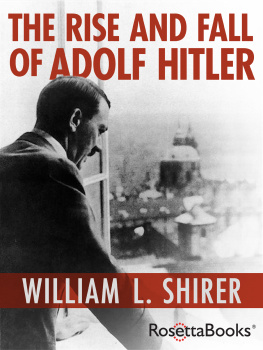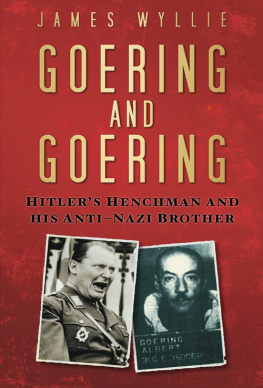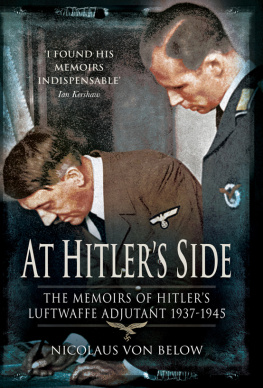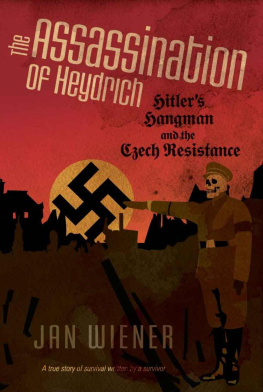W ALTER S CHELLENBERG
First published in Great Britain in 1956 as
The Schellenberg Memoirs: A Record of the Nazi Secret Service
This edition published in 2006 by
Andr Deutsch
an imprint of the
Carlton Publishing Group
20 Mortimer Street
London W1T 3JW
Text copyright Walter Schellenberg 1956
Translation copyright Louis Hagen 1956
Introduction copyright Alan Bullock 1956
Foreword copyright Richard J. Evans 2006
Design copyright Carlton Publishing Group 2006
The right of Walter Schellenberg to be identified as the author of this work has been asserted in accordance with the Copyright, Designs and Patents Act 1998.
All rights reserved.
This book is sold subject to the condition that it may not be reproduced, stored in a retrieval system or transmitted in any form or by any means, electronic, mechanical, photocopying, recording or otherwise, without the publishers prior consent.
A catalogue record for this book is available from the British Library.
ISBN 978-1-78012-249-6
eISBN 978-1-78012-251-9
Printed and bound in Great Britain by Mackays
Illustrations
T he publishers express their thanks to the Trustees of the Imperial War Museum for their kindness in making available for publication some of the photographs reproduced in this book.
Schellenberg before the war
Schellenbergs grave
Schellenberg at the Nuremberg trial
Hitler and Himmler watching Stormtroop manoeuvres
Goering just after his capture
Ribbentrop
Admiral Canaris
Bormann
Heydrich
Every effort has been made to acknowledge correctly and contact the source and/or copyright holder of each picture and Carlton Books Limited apologises for any unintentional errors or omissions that will be corrected in future editions of this book.
Foreword
By
Richard J. Evans
T HE REPUBLICATION of Walter Schellenbergs memoirs, 50 years after their first appearance in English, will be welcomed by everyone who is interested in the history of Nazi Germany, in the Second World War, and, more generally, in the profession of espionage. When they were published, in 1956, it was with an introduction by Alan Bullock, the British historian whose biography of Hitler, published four years before, had immediately established itself as the standard life, and was to remain so for many decades. Bullock was able to describe how the memoirs came into the hands of the publisher Andr Deutsch, to establish their basic authenticity and to make some wise and judicious remarks about their usefulness, their style and the character of their author. Bullocks introduction has stood the test of time, and is also reprinted in this volume. But inevitably, the intervening half-century has seen an enormous enlargement in our knowledge of Nazi Germany and the Second World War, and particularly of the context in which Schellenberg worked. Without going over the ground already covered by Bullock, it is the purpose of this Foreword to sketch in something of that context, and to show Schellenbergs relationship to it in more detail than Bullock was able to do, given the extreme paucity of research in the 1950s.
Who was Walter Schellenberg? Born in 1910, the seventh child of a piano manufacturer, he was one of the youngest members of that generation of middle-class German men too young to have fought in the First World War. They grew up in the 1920s in a febrile atmosphere in which nationalist resentments mixed with a determination to right Germanys wrongs by being more ruthless than the generations who had lost the war had proven to be. Germanys universities were hotbeds of extreme nationalism in the 1920s, and when Schellenberg entered Bonn University in 1929, the Nazi Students League was beginning to gain the mass support that would enable it to take over the national organisation of university students two years later. By 1930, the depression in the world economy had all but robbed his generation of any prospect of a career. With 35 per cent of the workforce unemployed in 1932, graduates from Germanys overcrowded universities came on to the job market with little hope of finding a job. The countrys economic collapse had destroyed many businesses, including that of Schellenbergs father, who was now unable to support his sons original intention of entering the diplomatic service. It was hardly surprising, therefore, that when Schellenberg was approached by two professors who asked him to write confidential reports on his university for the Security Service of the SS, he responded positively, becoming a member of the SS in March 1933. Schellenberg joined the Nazi Party shortly afterwards, at a time when Hitler, appointed Reich Chancellor on January 30, 1933,was establishing the Nazi dictatorship through a deadly combination of street violence, police terror and political manipulation, which resulted in the creation of a one-party state at the beginning of July.
The SS Security Service (Sicherheitsdienst, or SD), headed by former naval officer Reinhard Heydrich, was founded in 1931 in response to the fears of the leader of the SS, Heinrich Himmler, that the Nazi Party was being infiltrated by subversive elements and agents provocateurs. Heydrich quickly built the SD up into a powerful surveillance and information-gathering agency, and before long Schellenberg proved to be one of his most effective agents. In 1937, his immediate superior,Wilhelm Albert, described him in a confidential report in glowing terms: Character: open, impeccable, honest character: he is an SD-man. Will: firm, tough, possesses energy. Healthy common sense: thinks very sharply demonstrates a clear vision, caution, and immediately recognises the larger issues.
The RSHA was divided into a number of departments, each given the title of Amt (or office) and a number. Amt I and Amt II were concerned with internal administration; Amt III consisted of the domestic surveillance and intelligence apparatus of the SD; Amt IV was the new home for the Gestapo; Amt V was the criminal police; and Amt VII, a somewhat academic institution, concerned itself with researching and combating the ideological enemies of Nazism. Given that he had already been employed by Himmler and Heydrich on a number of foreign assignments, it was not surprising that Schellenbergs reward for his labours was to be given the deputy directorship of Amt IVE, the sub-division of the Gestapo responsible for counter-espionage in Germany and occupied Europe; in June 1940, he became its director. He continued to be used by Heydrich and Himmler on foreign assignments, most spectacularly in the abduction of two British secret service agents from the Dutch border town of Venlo on November 9, 1939, and in the arrest and interrogation of the Yugoslavian military attach in Berlin in April 1941. In this way, he brought himself to the attention of Hitler, who took a keen interest in such escapades; it was entirely characteristic of the Nazi leadership that a man like Schellenberg should be rewarded for activities that were wholly unofficial and spectacularly illegal.
Schellenbergs opportunity came with the invasion of the Soviet Union. For the SD was no mere bureaucratic organisation: already in September 1939 it had been charged with the formation of a number of task forces (Einsatzgruppen) to follow the army into Poland and deal with subversion in the conquered territories. In June 1941 it was commissioned to do the same, on a larger scale, following the invasion of the Soviet Union. The heavily armed, motorised units, each about 1,000 strong, soon began the mass shooting of Communist officials, alleged partisans and, above all, Jews. By the middle of 1942, their victims, whom they enumerated in detailed reports to Berlin, numbered hundreds of thousands. Schellenberg was fully involved in the preparations for this programme of murder, though in his memoirs (see
Next page










